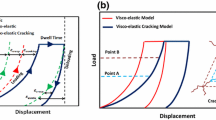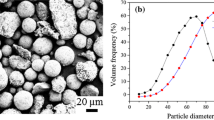Abstract
The presence of microcracks in materials affects a wide range of mechanical properties including elastic modulus, Poisson’s ratio, fracture strength, and fracture toughness. The microcrack-induced reductions of the Young’s modulus, E, and Poisson’s ratio, υ, are functions of the size, geometry, and number density of microcracks. In this study, an array of Vickers indentation-induced microcracks was placed on the surfaces of two hydroxyapatite (HA) specimens with totals of 391 and 513 indentations per specimen. This study tests the validity of theoretical studies of microcrack damage-induced changes in E and υ, where the changes are expressed either by (i) the volumetric crack number density, N and (ii) the crack damage parameter, ε. All elasticity measurements were done via resonant ultrasound spectroscopy. For both the HA specimens included in the study and alumina specimens indented in an earlier study [J Mater Sci 38:1910. doi: 10.1007/BF00595764, 1], E and υ decreased approximately linearly with increasing microcrack damage. The slopes of the E and υ versus N and ε are also computed and compared to the available theoretical models.









Similar content being viewed by others
References
Kim Y, Case ED, Gaynor S (1993) J Mater Sci 28:1910. doi:10.1007/BF00595764
Misra V, Pandey SD (2005) Bull Environ Contam Toxicol 74:725
da Silva OG, da Silva EC, da Fonseca MG, Arakaki LNH, Airoldi C (2006) J Colloid Interface Sci 302:485
Opre Z, Grunwaldt JD, Maciejewski M, Ferri D, Mallat T, Baiker A (2005) J Catal 230:406
Jamwal N, Gupta M, Paul S (2008) Green Chem 10:999
Rakap M, Ozkar S (2011) Int J Hydrogen Energy 36:7019
Silva CC, Almeida AFL, De Oliveira RS, Pinheiro AG, Goes JC, Sombra ASB (2003) J Mater Sci 38:3713. doi:10.1023/A:1025963728858
Silva CC, Rocha HHB, Freire FNA, Santos MRP, Saboia KDA, Goes JC, Sombra ASB (2005) Mater Chem Phys 92:260
El Mhammedi MA, Achak M, Najih R, Bakasse M, Chtaini A (2009) Mater Chem Phys 115:567
Mahabole MP, Aiyer RC, Ramakrishna CV, Sreedhar B, Khairnar RS (2005) Bull Mater Sci 28:535
Ohtsuki C, Ichikawa Y, Shibata H, Kawachi G, Torimoto T, Ogata S (2010) J Mater Sci Mater Med 21:1225
Owada H, Yamashita K, Umegaki T, Kanazawa T, Nagai M (1989) Solid State Ion 35:401
Hench LL (1991) J Am Ceram Soc 74:1487
Burg KJL, Porter S, Kellam JF (2000) Biomaterials 21:2347
Karageorgiou V, Kaplan D (2005) Biomaterials 26:5474
Martin HC, Carey GF (1973) Introduction to finite element analysis. McGraw-Hill, New York
Smith DT, Wei L (1995) J Am Ceram Soc 78:1301
Perera FH, Martinez-Vazquez FJ, Miranda P, Ortiz AL, Pajares A (2010) Ceram Int 36:1929
Chotard T, Soro J, Lemercier H, Huger M, Gault C (2008) J Eur Ceram Soc 28:2129
Patapy C, Gault C, Huger M, Chotard T (2009) J Eur Ceram Soc 29:3355
Yousef SG, Rodel J, Fuller ER Jr, Zimmermann A, El-Dasher BS (2005) J Am Ceram Soc 88:2809
Case ED, Glinka C (1984) J Mater Sci 19:2962. doi:10.1007/BF01026974
Wang J, Shaw LL (2009) Biomaterials 30:6565
Rokhlin SI, Chu YC, Hefetz M (1993) Ceram Eng Sci Proc 14:454
Diaz LA, Torrecillas R, Simonin F, Fantozzi G (2008) J Eur Ceram Soc 28:2853
Evans AG, Fu Y (1986) In: Evans AG (ed) Ceramic containing systems. Noyes Press, Park Ridge
Kratschmer T, Aneziris CG (2011) Int J Appl Ceram Technol 8:398
Hubner H, Jillek W (1977) J Mater Sci 12:117. doi:10.1007/BF00738476
Meschke F, Kolleck A, Schneider GA (1997) J Eur Ceram Soc 17:1143
Ota T, Yamai I, Takahashi J (1986) Adv Ceram Mater 1:371
Hilpert T, Ivers-Tiffee E (2004) Solid State Ion 175:471
Hasselman DPH (1993) J Am Ceram Soc 76:2180
Deroo F, Kim JY (2010) J Acoust Soc Am 127:3315
Kimura T, Miyamoto S, Yamaguchi T (1990) J Am Ceram Soc 73:127
Morito K, Suzuki T (2005) J Appl Phys 97:104
Rice RW (2002) J Eur Ceram Soc 22:1411
Lee SK, Moretti JD, Readey MJ (2002) J Am Ceram Soc 85:279
Collin M, Rowcliffe D (2002) J Eur Ceram Soc 22:435
Wilson BA, Case ED (1997) J Mater Sci 32:3163. doi:10.1023/A:1018698600884
Wilson BA, Case ED (1999) J Mater Sci 34:247. doi:10.1023/A:1004484901369
Wilson BA, Lee KY, Case ED (1997) Mater Res Bull 32:1607
Kese KO, Li ZC, Bergman B (2006) J Eur Ceram Soc 26:1013
Braun LM, Bennison SJ, Lawn BR (1992) J Am Ceram Soc 75:3049
Salomonson J, Zeng K, Rowcliffe D (1996) Acta Mater 44:543
Kim JW, Bhowmick S, Hermann I, Lawn BR (2006) J Biomed Mater Res B 79:58
Budiansky B, O’Connell RJ (1976) Int J Solids Str 12:81
Salganik RL (1974) Mech Solids 8:135
Hoenig A (1979) Int J Solids Str 15:137
Laws N, Brockenbrough JR (1987) Int J Solids Str 23:1247
Hasselman DPH, Singh JP (1979) Am Ceram Soc Bull 58:856
Walsh JB (1965) J Geophys Res 70:5249
Case ED (1984) J Mater Sci 19:3702. doi:10.1007/BF02396943
Case ED, Kim Y (1993) J Mater Sci 28:1885. doi:10.1007/BF00595762
Kim Y, Case ED (1993) J Mater Sci 28:1901. doi:10.1007/BF00595763
Dorre E, Hubner H (1984) Alumina: processing, properties, and applications. Springer, Berlin
Case ED, Smyth JR, Monthei V (1981) J Am Ceram Soc 64:C24
Migliori A, Sarrao JL (1997) Resonant ultrasound spectroscopy applications to physics, materials measurements and nondestructive evaluation. Wiley-Interscience, Hoboken
Ren F, Case ED, Morrison A, Tafesse M, Baumann MJ (2009) Philos Mag 89:1163
Schmidt RD, Ni JE, Case ED, Sakamoto JS, Kleinow DC, Wing BL, Stewart RC, Timm EJ (2010) J Alloy Compd 504:303
Ni JE, Case ED, Khabir KN, Stewart RC, Wu CI, Hogan TP, Timm EJ, Girard SN, Kanatzidis MG (2010) Mater Sci Eng B 170:58
Zhang L, Rogl G, Grytsiv A, Puchegger S, Koppensteiner J, Spieckermann F, Kabelka H, Reinecker M, Rogl P, Schranz W, Zehetbauer M, Carpenter MA (2010) Mater Sci Eng B 170:26
Gladden JR, Li G, Adebisi R, Firdosy S, Caillat T, Ravi V (2010) Phys Rev B 82:045209
Ni JE, Ren F, Case ED, Timm EJ (2009) Mater Chem Phys 118:459
Zhang Z, Keppens V, Senkov ON, Miracle DB (2007) Mater Sci Eng A 471:151
Wachtman JB, Cannon WR, Matthewson MJ (2009) Mechanical properties of ceramics, 2nd edn. Wiley, New York
Anstis GR, Chantikul P, Lawn BR, Marshall DB (1981) J Am Ceram Soc 64:533
Spriggs RM (1961) J Am Ceram Soc 44:628
Liu DM (1998) Ceram Int 24:441
Arita IH, Castano VM, Wilkinson DS (1995) J Mater Sci Mater Med 6:19
He LH, Standard OC, Huanga TTY, Latella BA, Swain MV (2008) Acta Biomater 4:577
Landolt H, Bornstein R (1979) Elektrische, Piezoelektrische, Pyroelektrische, Piezooptische, Elektrooptische Konstanten und Nichtlineare Dielektrische Suszeptibilitaten, Zahlenwerte und Funktionen aus Naturwissenschaften und Technik, Gruppe III, Bd. 11. Springer, Berlin
Hoepfner TP, Case ED (2004) Mater Lett 58:489
Dey A, Mukhopadhyay AK (2011) Int J Appl Ceram Technol 8:572
Wang Q, Ji SC (2009) J Geophys Res-Earth 114:B09202
Rice RW (1998) Porosity of ceramics. Marcel Dekker, Inc., New York
Jang BK, Matsubara H (2005) Mater Lett 59:3462
Ren F, Case ED, Timm EJ, Schock HJ (2007) Philos Mag 87:4907
Krstic Z, Krstic VD (2008) J Eur Ceram Soc 28:1723
Ren F, Case ED, Ni JE, Timm EJ, Lara-Curzio E, Trejo RM, Lin CH, Kanatzidis MG (2009) Philos Mag 89:143
Zhou J, Li Z, Zhu R, Li Y, Zhang Z (2008) J Mater Process Technol 197:325
Dole SL, Hunter O Jr, Calderwood FW, Bray DJ (1978) J Am Ceram Soc 61:486
Case ED, Smyth JR, Hunter O Jr (1981) J Nucl Mater 102:135
Manning WR, Hunter O Jr (1973) J Am Ceram Soc 56:602
Suchomel RR, Hunter O Jr (1976) J Am Ceram Soc 59:149
Acknowledgements
The authors acknowledge the financial support of the National Science Foundation, Division of Materials Research Grant DMR-0706449. Also, the purchase of the Resonant Ultrasound Spectroscopy apparatus was funded by the Defense University Research Instrumentation Program (DURIP) Grant No. N00014-07-1-0735.
Author information
Authors and Affiliations
Corresponding author
Appendices
Appendix 1
Equations to calculate S N [the product of a crack orientation and a crack geometry parameter in Eq. (9)], for each modulus/microcrack model with a particular crack geometry employed in this study.
In the ROM model [53], the overall modulus was taken as the sum modulus of the undamaged layer and the damaged layer. The strain in the undamaged layer was set equal to the strain in the damaged layer. In the DBV model [53], the Bernoulli–Euler beam equation was applied with the boundary conditions that both the bending moments and the shear force were zero at the beam ends.
In the ROM model [53], S N [Eq. (9)] was calculated using Eq. (12)
In the DBV model [53], S N was expressed as Eq. (13)
In both the Eqs. (12) and (13), f is the microcrack orientation parameter, 〈A 2〉 is the mean of the square of the crack surface area and 〈P〉 is the mean crack perimeter. In Eq. (13), r is the ratio between the half the crack length and the specimen thickness [53].
Equations to calculate S N for different crack geometries in the ROM model are summarized in Eqs. (14)–(17).
ROM model with unmodified slit crack geometry
ROM model with modified slit crack geometry
ROM model with unmodified half ellipse crack geometry
ROM model with modified half ellipse crack geometry
The value of S N for DBV model is calculated via multiplying each corresponding S N value for ROM model by \( \frac{{r^{2} + 3}}{{(r + 1)^{2} }}, \) where r is the ratio between the half the crack length and the specimen thickness.
Appendix 2
Equations used to predict the slopes, S p, of the ΔE/E 0 versus ε plots for HA specimens in this study and alumina [1].
The relative change in Young’s modulus, ΔE/E 0 in DBV model [from Eqs. (11) and (28) in Case’s article [53]) is given by
where f is the microcrack orientation parameter, for aligned microcracks in penny, half penny, ellipse, and half ellipse crack shapes (from Table II in Kim and Case’s article [54]), f is defined as
for aligned slit crack shapes (from Table II in Kim and Case’s article [54])
G is the geometry parameter [from Eq. (4) in Kim and Case’s article [54]]
For DBV model with modified half ellipse crack geometry (from Table II in Kim and Case’s article [54])
For the DBV model with a modified slit crack geometry (from Table II in Kim and Case [54])
N l is the microcrack number density in the microcracked surface layer.
N l is the number of microcracks/(specimen length × specimen width × depth of the microcrack-damaged layer), r is the depth of the microcracked layer/depth of the unmicrocracked layer.
In the plot of ΔE/E 0 versus ε for HA specimens in this study and alumina specimens [1], ε is defined as GN l. The theoretically predicted slope, S p of ΔE/E 0 versus ε is expressed as
Rights and permissions
About this article
Cite this article
Fan, X., Case, E.D. & Baumann, M.J. The effect of indentation-induced microcracks on the elastic modulus of hydroxyapatite. J Mater Sci 47, 6333–6345 (2012). https://doi.org/10.1007/s10853-012-6556-2
Received:
Accepted:
Published:
Issue Date:
DOI: https://doi.org/10.1007/s10853-012-6556-2




